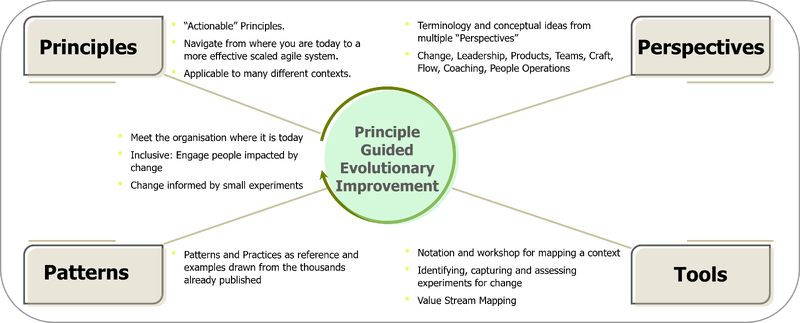What is ELSE?: Difference between revisions
Jump to navigation
Jump to search
| Line 10: | Line 10: | ||
The key elements of ESE are shown in the diagram below: | The key elements of ESE are shown in the diagram below: | ||
[[File:SA Overview V2.1.png|frameless| | [[File:SA Overview V2.1.png|frameless|800x800px]] | ||
==== Wiki sections summarised: ==== | ==== Wiki sections summarised: ==== | ||
Revision as of 12:37, 24 January 2024
At its heart, ELSE is a Principle-Guided Evolutionary Improvement process that applies a set of Actionable Principles to understand the Current Context and Guide the direction of change. The result is an ever-evolving set of Emergent Practices adapted to support the organisation as it develops over time.
In summary:
ELSE is a continuous improvement approach that fosters emergent practices, guided by actionable principles, to enhance organisational agility at scale.
The key elements of ESE are shown in the diagram below:
Wiki sections summarised:
- Perspectives - covers the concepts underpinning the principles and introduces many important terms used.
- Change - explains the Incremental Evolutionary Improvement Process.
- Leadership - discusses the shift required in Leadership style to support greater organisational agility successfully.
- Product - explores “Product” and “Ownership”. Product deals with how to shape products and services, using the idea of a composite value stream for multipart products where applicable. Ownership looks at the models for Product Ownership at scale.
- Teams - reviews the essential elements of what makes an Agile team so successful as a unit for value creation. It then explores concepts that help expand the number of teams whilst retaining the essential elements.
- Coaching - explains why coaching is important in increasing the probability of successful and sustained change.
- Principles - The principles are intentionally brief and hopefully to the point! They are categorised to make them easier to navigate.
- General - principles are higher-level or meta principles are intrinsic to the more detailed principles in the other categories.
- Teams - principles guide how teams are structured.
- Craft - principles point the direction of engineering or the “Delivery domain” craft skill and practice improvement required for multiple collaborating teams to increase their sustained success.
- Leadership - principles guide how leadership behaviours shape and support an environment that continually improves how it supports its people and their capability to derive value.
- Product Ownership - principles guide how to scale Product Ownership just enough for the context.
- Defining Products - provides direction on evolving the shape of products and services.
- Practices - Concrete patterns and practices are not the primary goal for this body of work, as countless options can be harvested from published scaling frameworks and other sources. In the process of constructing the principles, we occasionally found it useful to explore potential patterns and practices and have added these.
- Tools - This section identifies some useful tools for engaging stakeholders in collaborative workshops to map and explore the current context to identify improvement directions.
- Glossary - Here, we explain the meaning ascribed to key terms used in the principles and perspectives.
- References - A list of supporting publications.
